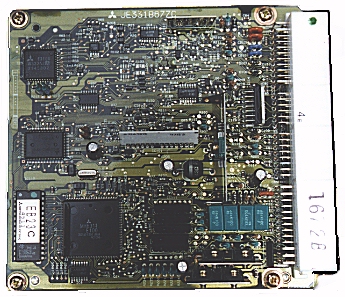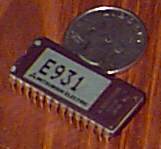Technomotive's glossary of common engine computer terms
 ECU (Engine
Control Unit) - This is the brain of the car. It uses the input from
all of the sensors on the engine to determine optimum spark advance and fuel
delivery for the engine. Most modern ECUs can also control other items such as
the air conditioner, alternator, and choke. The reason all modern cars have
ECUs instead of mechanical carbuerators is that ECUs can better respond to the
many variables that make up an engine's performance curve. Remember the days of
tuning jets on a carb, and playing with chokes? An ECU can do equivalent
control of those things all by itself and compensate for (tune) the engine as it
ages. Computers were initially introduced into automobiles to bring their smog
levels down. Now they are used to eke out the last bit of performance out of
relatively tiny four-cylinder engines.
ECU (Engine
Control Unit) - This is the brain of the car. It uses the input from
all of the sensors on the engine to determine optimum spark advance and fuel
delivery for the engine. Most modern ECUs can also control other items such as
the air conditioner, alternator, and choke. The reason all modern cars have
ECUs instead of mechanical carbuerators is that ECUs can better respond to the
many variables that make up an engine's performance curve. Remember the days of
tuning jets on a carb, and playing with chokes? An ECU can do equivalent
control of those things all by itself and compensate for (tune) the engine as it
ages. Computers were initially introduced into automobiles to bring their smog
levels down. Now they are used to eke out the last bit of performance out of
relatively tiny four-cylinder engines.
 EPROM
- Let's start with the last three letters. ROM means Read-Only Memory. This is
a permanent storage place for computer programs. Computers can read their
operating program from this device. It cannot be written over (as opposed to
RAM, which we are sure you have heard of). It is made with the computer program
already etched in right at the factory. PROM means Programmable ROM. A PROM is
a device like a ROM, except that it leaves the factory blank and can be filled
with a program once, and only once. An EPROM is an Erasable PROM. It can be
erased after being written, but only with an intense ultra-violet light source.
That is typically why you see thick labels on them - so they won't accidentally
get erased due to prolonged exposure to sunlight or flourescent lights. Why
don't auto manufacturers use ROMs or PROMs instead of EPROMS? We suspect that
at the beginning of a model year, many things in the ECU computer program are
still in flux. After all, the smog testing for the entire model line may not
have been completed yet, and the smog rules themselves might have changed since
they designed the car. In order to accomodate any last minute quick fixes, the
manufacturers use EPROMs so they won't get stuck with a bunch of ECUs that have
the wrong program in them.
EPROM
- Let's start with the last three letters. ROM means Read-Only Memory. This is
a permanent storage place for computer programs. Computers can read their
operating program from this device. It cannot be written over (as opposed to
RAM, which we are sure you have heard of). It is made with the computer program
already etched in right at the factory. PROM means Programmable ROM. A PROM is
a device like a ROM, except that it leaves the factory blank and can be filled
with a program once, and only once. An EPROM is an Erasable PROM. It can be
erased after being written, but only with an intense ultra-violet light source.
That is typically why you see thick labels on them - so they won't accidentally
get erased due to prolonged exposure to sunlight or flourescent lights. Why
don't auto manufacturers use ROMs or PROMs instead of EPROMS? We suspect that
at the beginning of a model year, many things in the ECU computer program are
still in flux. After all, the smog testing for the entire model line may not
have been completed yet, and the smog rules themselves might have changed since
they designed the car. In order to accomodate any last minute quick fixes, the
manufacturers use EPROMs so they won't get stuck with a bunch of ECUs that have
the wrong program in them.
MAF (Mass Airflow Sensor) or MAS (Mass Air Sensor)
- Most commonly found on Mitsubishi vehicles, this sensor is used by the
ECU to determine the amount of air entering the engine.
Notice that "amount of air" is different from "volume of air"
depending on the air temperature and pressure. The MAF actually uses three
different sensors to determine the amount of air. The most important sensor is
the airflow sensor. For this task, Mitsubishi employs a Karmaan Vortex sensor.
Long story short, this sensor works by disturbing a laminar flow of air, causing
vortices which spin in alternate directions. An ultrasonic transducer detects
these vortices, and sends a pulse to the ECU every time one passes by. The MAF
also has a barometric pressure sensor and temperature sensor. If you remember
PV=nRT from freshman chemistry, you'll see that we have P, V,
and T - since R is a constant, we now have n, which is
the amount of air. Although a bit more restrictive than other methods due to
the need for a laminar flow, the Mitsubishi MAF has the advantage of not
depending on the volumetric efficiency of the engine. Thus, when you upgrade
various engine, intake, or exhaust components, you do not neccessarily have to
reconfigure the ECU's fuel and spark program.
©1997 Technomotive
September
29th, 1997
 ECU (Engine
Control Unit) - This is the brain of the car. It uses the input from
all of the sensors on the engine to determine optimum spark advance and fuel
delivery for the engine. Most modern ECUs can also control other items such as
the air conditioner, alternator, and choke. The reason all modern cars have
ECUs instead of mechanical carbuerators is that ECUs can better respond to the
many variables that make up an engine's performance curve. Remember the days of
tuning jets on a carb, and playing with chokes? An ECU can do equivalent
control of those things all by itself and compensate for (tune) the engine as it
ages. Computers were initially introduced into automobiles to bring their smog
levels down. Now they are used to eke out the last bit of performance out of
relatively tiny four-cylinder engines.
ECU (Engine
Control Unit) - This is the brain of the car. It uses the input from
all of the sensors on the engine to determine optimum spark advance and fuel
delivery for the engine. Most modern ECUs can also control other items such as
the air conditioner, alternator, and choke. The reason all modern cars have
ECUs instead of mechanical carbuerators is that ECUs can better respond to the
many variables that make up an engine's performance curve. Remember the days of
tuning jets on a carb, and playing with chokes? An ECU can do equivalent
control of those things all by itself and compensate for (tune) the engine as it
ages. Computers were initially introduced into automobiles to bring their smog
levels down. Now they are used to eke out the last bit of performance out of
relatively tiny four-cylinder engines.